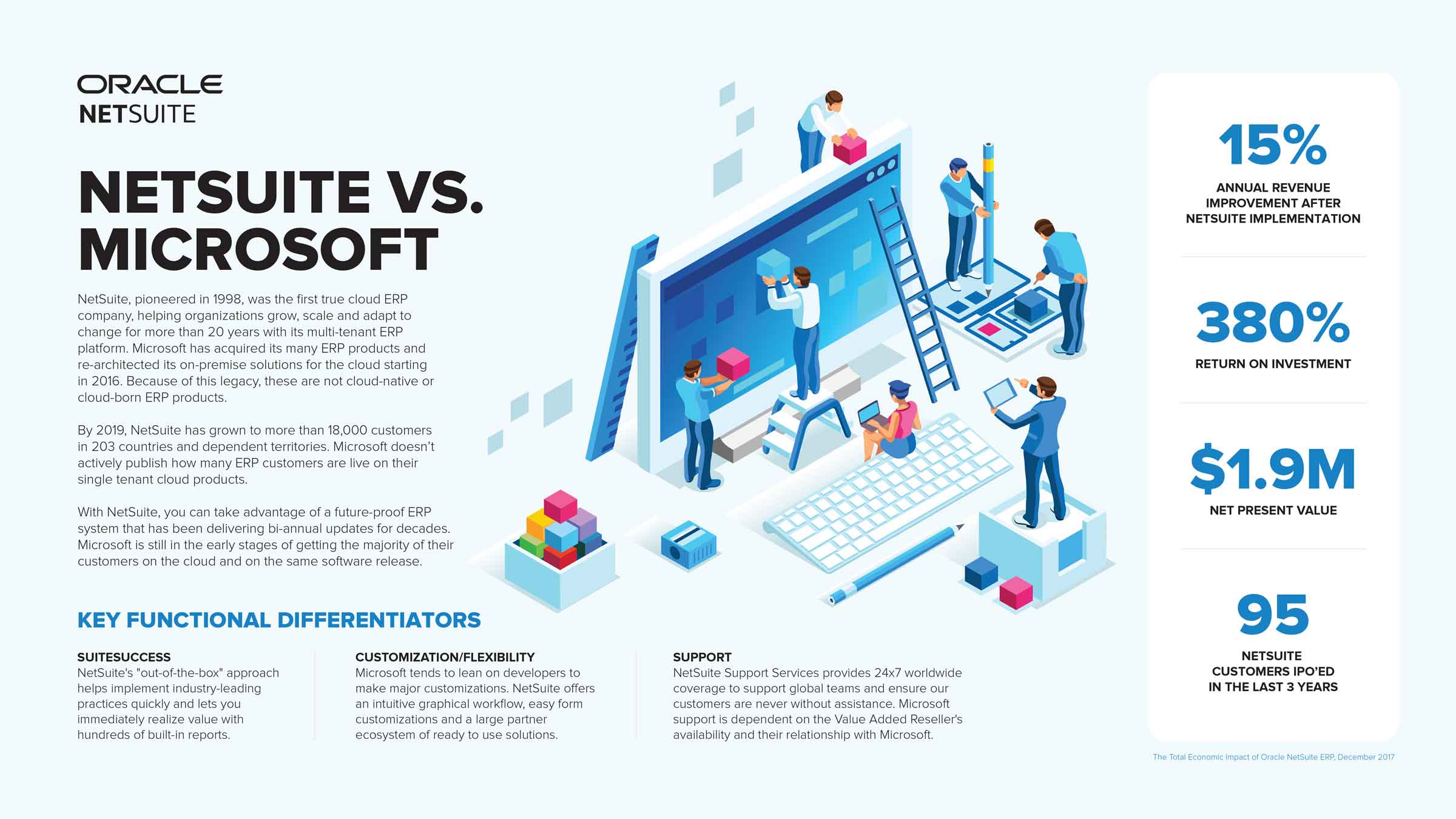Compare Microsoft Dynamics vs. NetSuite
Read time: 3 min.
When you’re considering new business software, two major titans in the industry you’ll likely explore are Oracle and Microsoft. Both have popular cloud-based options: NetSuite from Oracle and Microsoft Dynamics from Microsoft. Each commonly go head-to-head due to their similarities; however, they have significant differences. Let’s explore Microsoft Dynamics vs. NetSuite.
Key differentiators of Microsoft Dynamics vs. NetSuite
NetSuite and Microsoft Dynamics have a multi-decade history of offering business solutions but took distinct paths to where they are currently. Many of these differences stem from their separate origins and how they became the cloud-based solutions they are today. Some key differentiators include:
- SuiteSuccess: This “out-of-the-box” approach allows you to take advantage of NetSuite’s industry-leading tools quickly and see value and a return on investment with built-in reports. In fact, customers see an average of 15 percent annual revenue improvement after a NetSuite implementation and a 380 percent return on investment.
- Customization: Microsoft’s go-to marketing strategy is to deliver most of what many businesses need in their ERP solution but rely on integrating custom-built partner solutions to get most customers the full functionality they need. NetSuite is an out-of-the-box solution, meaning everything you need to run your business is included from the beginning.
- Support: While a large corporation with accessible support, Microsoft’s requirement to integrate partner solutions means that if a tool within your software isn’t working correctly, you are likely at the mercy of the partner’s support team hours.
True cloud and pseudo cloud
While both are considered cloud solutions, Microsoft Dynamics is a reworked version of their original on-premise software, now offered in the cloud. NetSuite, however, is the first ERP solution built for the cloud. Some other ways these differ are:
- Cost: Solutions like Microsoft Dynamics that are on-premise solutions hosted in the cloud still require pricey upgrades, costing your business more in the long run. When considering the necessary budget for a Microsoft Dynamics project, include about 25 percent of the implementation price in each year’s costs in order to pay for the required upgrade you’ll have to perform when the next update is released.
- Scale: Microsoft’s business solutions within the Dynamics family have gaps in their functionality. Their solution for small-to-mid-sized businesses may work for you now, but once you outgrow them, you might be forced to restrict your growth or migrate to a solution much larger than you need. This can make your software much more expensive. Since NetSuite comes with all essential functionality included, your solution will grow with you. You can use the modules you need as you need them – no extra cost required.
Keep it simple, safely
At its core, staying up to date on software is easier with NetSuite compared to Microsoft Dynamics due to its automatic updates. Without regular, large upgrade projects you’ll have increased business agility. With NetSuite, you can focus on your operations and services, not ERP maintenance. More benefits of NetSuite over Microsoft Dynamics are:
- Self-service and mobility: Your employees are on the go. NetSuite is, too, with real-time access to dashboards, data and more anywhere and at any time through mobile apps and devices.
- Reduced spreadsheet-based accounting: While Microsoft Dynamics may require multiple programs or customizations to maintain data, companies pick up the slack for this isolated data system with what is called “spreadsheet-based accounting.” NetSuite, which began as accounting software, has an integrated suite that lives and works in the cloud, eliminating the need for a workaround.
- Global deployment: Global organizations can oversee multiple subsidiaries easily within NetSuite. Manage different currencies, tax rules, languages and reporting requirements easily within one system. Consolidating multi-subsidiary and multinational financials with Microsoft Dynamics is both time-consuming and expensive, requiring multiple spreadsheets or investing in separate accounts for each subsidiary or division.




